I asked a question about the same problem earlier, but because my approach has changed I now have different questions.
My current code:
from sklearn import preprocessing
from openpyxl import load_workbook
import numpy as np
from numpy import exp, array, random, dot
from sklearn.model_selection import train_test_split
from sklearn.neural_network import MLPRegressor
from sklearn.preprocessing import StandardScaler
from sklearn.metrics import classification_report,confusion_matrix
import matplotlib.pyplot as plt
from sklearn.linear_model import LinearRegression
#Set sizes
rowSize = 200
numColumns = 4
# read from excel file
wb = load_workbook('python_excel_read.xlsx')
sheet_1 = wb["Sheet1"]
date = np.zeros(rowSize)
day = np.zeros(rowSize)
rain = np.zeros(rowSize)
temp = np.zeros(rowSize)
out = np.zeros(rowSize)
for i in range(0, rowSize):
date[i] = sheet_1.cell(row=i + 1, column=1).value
day[i] = sheet_1.cell(row=i + 1, column=2).value
rain[i] = sheet_1.cell(row=i + 1, column=3).value
temp[i] = sheet_1.cell(row=i + 1, column=4).value
out[i] = sheet_1.cell(row=i + 1, column=5).value
train = np.zeros(shape=(rowSize,numColumns))
t_o = np.zeros(shape=(rowSize,1))
for i in range(0, rowSize):
train[i] = [date[i], day[i], rain[i], temp[i]]
t_o[i] = [out[i]]
X = train
# Output
y = t_o
X_train, X_test, y_train, y_test = train_test_split(X, y)
####Neural Net
nn = MLPRegressor(
hidden_layer_sizes=(3,), activation='relu', solver='adam', alpha=0.001, batch_size='auto',
learning_rate='constant', learning_rate_init=0.01, power_t=0.5, max_iter=10000, shuffle=True,
random_state=9, tol=0.0001, verbose=False, warm_start=False, momentum=0.9, nesterovs_momentum=True,
early_stopping=False, validation_fraction=0.1, beta_1=0.9, beta_2=0.999, epsilon=1e-08)
nn.fit(X_train, y_train.ravel())
y_pred = nn.predict(X_test)
###Linear Regression
# lm = LinearRegression()
# lm.fit(X_train,y_train)
# y_pred = lm.predict(X_test)
fig = plt.figure()
ax1 = fig.add_subplot(111)
ax1.scatter(X_test[:,0], y_pred, s=1, c='b', marker="s", label='real')
ax1.scatter(X_test[:,0], y_test, s=10, c='r', marker="o", label='NN Prediction')
plt.show()
#Calc MSE
mse = np.square(y_test-y_pred).mean()
print(mse)
The results from this show a pretty bad prediction of the test data. Because I am new to this, I am not sure if it is my data, the model, or my coding. Based on the plot, I believe the model is wrong for the data (the model seems to predict something near linear or squared, while the actual data seems much more spread out)
Here are some of the data points: formatted as Day of year(2 is jan 2nd), weekday(1)/weekend(0), rain(1)/no rain(0), Temp in F, attendance (this is output)
2 0 0 51 1366
4 0 0 62 538
5 1 0 71 317
6 1 0 76 174
7 1 0 78 176
8 1 0 68 220
12 1 1 64 256
13 1 1 60 379
14 1 0 64 316
18 0 0 72 758
19 1 0 72 1038
20 1 0 72 405
21 1 0 71 326
24 0 0 74 867
26 1 1 68 521
27 1 0 71 381
28 1 0 72 343
29 1 1 68 266
30 0 1 57 479
31 0 1 57 717
33 1 0 70 542
34 1 0 73 220
35 1 0 74 360
36 1 0 79 444
42 1 0 78 534
45 0 0 80 1572
52 0 0 76 1236
55 1 1 64 689
56 1 0 69 726
59 0 0 67 1188
60 0 0 74 1140
61 1 1 63 979
62 1 1 62 657
63 1 0 67 687
64 1 0 72 615
67 0 0 80 1074
68 1 0 81 1261
71 1 0 83 1332
73 0 0 85 1259
74 0 0 86 1142
76 1 0 88 1207
77 1 1 78 1438
82 1 0 85 1251
83 1 0 83 1019
85 1 0 86 1178
86 0 0 92 1306
87 0 0 92 1273
89 1 0 93 1101
90 1 0 92 1274
93 0 0 83 1548
94 0 0 86 1318
96 1 0 83 1395
97 1 0 81 1338
98 1 0 75 1240
100 0 0 84 1335
102 0 0 83 931
103 1 0 87 746
104 1 0 91 746
105 1 0 81 600
106 1 0 72 852
108 0 1 87 1204
109 0 0 89 1191
110 1 0 90 769
111 1 0 88 642
112 1 0 86 743
114 0 1 75 1085
115 0 1 78 1109
117 1 0 84 871
120 1 0 96 599
123 0 0 93 651
129 0 0 74 1325
133 1 0 88 637
134 1 0 84 470
135 0 1 73 980
136 0 0 72 1096
137 0 0 83 792
138 1 0 87 565
139 1 0 84 501
141 1 0 88 615
142 0 0 79 722
143 0 0 80 1363
144 0 0 82 1506
146 1 0 93 626
147 1 0 94 415
148 1 0 95 596
149 0 0 100 532
150 0 0 102 784
154 1 0 99 514
155 1 0 94 495
156 0 1 87 689
157 0 1 94 931
158 0 0 97 618
161 1 0 92 451
162 1 0 97 574
164 0 0 102 898
165 0 0 104 746
166 1 0 109 587
167 1 0 109 465
174 1 0 108 514
175 1 0 109 572
179 0 0 107 811
181 1 0 104 423
182 1 0 103 526
184 0 1 97 849
185 0 0 103 852
189 1 0 106 728
191 0 0 101 577
194 1 0 105 511
198 0 1 101 616
199 0 1 97 1056
200 0 0 94 740
202 1 0 103 498
205 0 0 101 610
206 0 0 106 944
207 0 0 105 769
208 1 0 103 551
209 1 0 103 624
210 1 0 97 513
212 0 1 107 561
213 0 0 100 905
214 0 0 105 767
215 1 0 107 510
216 1 0 108 406
217 1 0 109 439
218 1 0 103 427
219 0 1 104 460
224 1 0 105 213
227 0 0 112 834
228 0 0 109 615
229 1 0 105 216
230 1 0 104 213
231 1 0 104 256
232 1 0 104 282
235 0 0 104 569
238 1 0 103 165
239 1 1 105 176
241 0 1 108 727
242 0 1 105 652
243 1 1 103 231
244 1 0 96 117
245 1 1 98 168
246 1 1 97 113
247 0 0 95 227
248 0 0 92 1050
249 0 0 101 1274
250 1 1 95 1148
254 0 0 99 180
255 0 0 104 557
258 1 0 94 228
260 1 0 95 133
263 0 0 100 511
264 1 1 89 249
265 1 1 90 245
267 1 0 101 390
272 1 0 100 223
273 1 0 103 194
274 1 0 103 150
275 0 0 95 224
276 0 0 92 705
277 0 1 92 504
279 1 1 77 331
281 1 0 89 268
284 0 0 95 566
285 1 0 94 579
286 1 0 95 420
288 1 0 93 392
289 0 1 94 525
290 0 1 86 670
291 0 1 89 488
294 1 1 74 295
296 0 0 81 314
299 1 0 88 211
301 1 0 84 246
303 0 1 76 433
304 0 0 80 216
307 1 1 80 275
308 1 1 66 319
312 0 0 80 413
313 1 0 78 278
316 1 0 74 305
320 1 1 57 323
324 0 0 76 220
326 0 0 77 461
327 1 0 78 510
331 0 0 60 1701
334 1 0 58 237
335 1 0 62 355
336 1 0 68 266
338 0 0 70 246
342 1 0 72 109
343 1 0 70 103
347 0 0 58 486
349 1 0 52 144
350 1 0 53 209
351 1 0 55 289
354 0 0 62 707
355 1 0 59 903
359 0 0 58 481
360 0 0 53 1342
364 1 0 57 1624
I have over a thousand data points in total, but Im not using them all for training/testing. One thought is I need more, another is that I need more factors because temp/rain/day of week does not affect attendance enough.
What can I do to make my model more accurate and give better predictions?
Thanks
EDIT: I added more data points and another factor. I cant seem to upload the excel file so I put the data on here with a better explanation of how it is formatted
EDIT: Here is the most recent code:
from sklearn import preprocessing
from openpyxl import load_workbook
import numpy as np
from numpy import exp, array, random, dot
from sklearn.model_selection import train_test_split
from sklearn.neural_network import MLPRegressor
from sklearn.preprocessing import StandardScaler
from sklearn.metrics import classification_report,confusion_matrix
import matplotlib.pyplot as plt
from sklearn.linear_model import LinearRegression
from sklearn.model_selection import KFold
from sklearn.model_selection import cross_val_predict
from sklearn import svm
from sklearn.model_selection import cross_val_score
from sklearn.metrics import confusion_matrix
from sklearn.preprocessing import StandardScaler
from sklearn.pipeline import Pipeline
from sklearn.model_selection import LeaveOneOut
#Set sizes
rowSize = 500
numColumns = 254
# read from excel file
wb = load_workbook('python_excel_read.xlsx')
sheet_1 = wb["Sheet1"]
input = np.zeros(shape=(rowSize,numColumns))
out = np.zeros(rowSize)
for i in range(0, rowSize):
for j in range(0,numColumns):
input[i,j] = sheet_1.cell(row=i + 1, column=j+1).value
out[i] = sheet_1.cell(row=i + 1, column=numColumns+1).value
output = np.zeros(shape=(rowSize,1))
for i in range(0, rowSize):
output[i] = [out[i]]
X = input
# Output
y = output
print(X)
print(y)
y[y < 500] = 0
y[np.logical_and(y >= 500, y <= 1000)] = 1
y[np.logical_and(y > 1000, y <= 1200)] = 2
y[y > 1200] = 3
# Use cross-validation
#kf = KFold(n_splits = 10, random_state=0)
loo = LeaveOneOut()
# Try different models
clf = svm.SVC()
scaler = StandardScaler()
pipe = Pipeline([('scaler', scaler), ('svc', clf)])
accuracy = cross_val_score(pipe, X, y.ravel(), cv = loo, scoring = "accuracy")
print(accuracy.mean())
#y_pred = cross_val_predict(clf, X, y.ravel(), cv = kf)
#cm = confusion_matrix(y, y_pred)
and here is the up to date data with as many features as I could add. note this is a random sample from the full data:
Current output: 0.6230954290296712
My ultimate goal is to achieve 90% or higher accuracy... I dont believe I can find more features, but will continue to gather as many as possible if helpful

